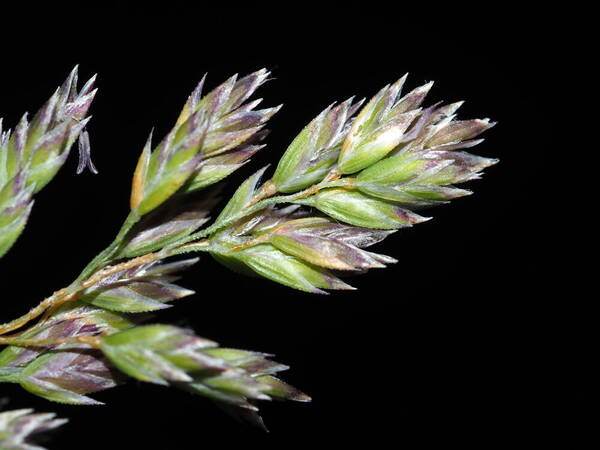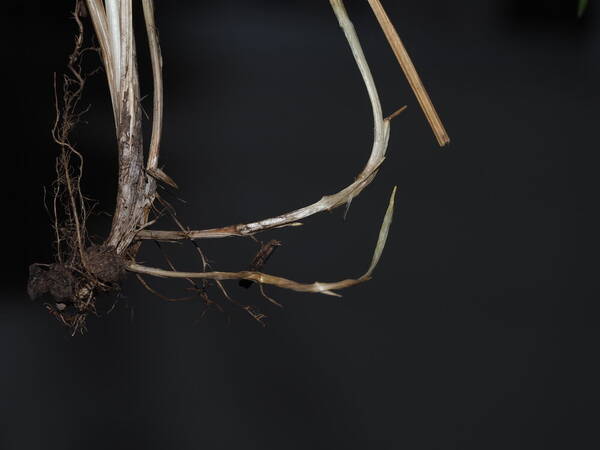Info
Subfamily: Pooideae
Genus etymology: Poa is the ancient Greek name for a herb of grass
Species etymology: pratensis = "of meadows" [Latin] refering to its habitat
Photosynthetic type: C3 (cool season)
Nativity: naturalized - intentional
First recorded in Hawaiʻi: 1879
Map


Inflorescence








Habit

Spikelets




Landscape


Collar



Rhizomes

Description
Plants perennial; green or anthocyanic, sometimes glaucous; extensively rhizomatous, densely to loosely tufted or the shoots solitary. Basal branching mainly extravaginal or evenly extra- and intravaginal. Culms 5-70(100) cm, erect or the bases decumbent, not branching above the base, terete or weakly compressed; nodes terete or weakly compressed, 1-2(3) exposed, proximal node(s) usually not exserted. Sheaths closed for 1/4-1/2 their length, terete to slightly compressed, glabrous or infrequently sparsely to moderately hairy, bases of basal sheaths glabrous, not swollen, distal sheath lengths 1.2-5(6.2) times blade lengths; collars smooth, glabrous; ligules 0.9-2(3.1) mm, smooth or scabrous, truncate to rounded, infrequently obtuse, ciliolate or glabrous; blades of extravaginal innovations like those of the culms, those of the intravaginal shoots sometimes distinctly narrower, 0.4-1 mm wide, flat to involute; cauline blades 0.4-4.5 mm wide, flat, folded, or involute, soft and lax to moderately firm, abaxial surfaces smooth, glabrous, adaxial surfaces smooth or sparsely scabrous, frequently sparsely hairy, hairs 0.2-0.8 mm, erect to appressed, slender, curving, sinuous or straight, apices usually broadly prow-shaped, sometimes narrowly prow-shaped, blades subequal, the middle blades longest, the flag leaf blades 1.5-10 cm. Panicles 2-15(20) cm, narrowly ovoid to narrowly or broadly pyramidal, loosely contracted to open, sparse to moderately congested, with (25) 30-100+ spikelets and (1)2-7(9) branches per node; branches (1)2-9 cm, spreading early or late, terete or angled, smooth or sparsely to moderately densely scabrous, with 4-30(50) spikelets usually fairly crowded in the distal 1/2. Spikelets 3.5-6(7) mm, lengths 3.5 times widths, laterally compressed, sometimes bulbiferous; florets 2-5, usually normal, sometimes bulb-forming; rachilla internodes usually shorter than 1 mm, smooth, glabrous. Glumes unequal to subequal, usually distinctly shorter than the adjacent lemmas, narrowly lanceolate to lanceolate, infrequently broadly lanceolate, distinctly keeled, keels usually sparsely to densely scabrous, infrequently smooth; lower glumes 1.5-4(4.5) mm, usually narrowly lanceolate to lanceolate, occasionally sickle-shaped, 1-3-veined; upper glumes 2-4.5(5) mm, distinctly shorter than to nearly equaling the lowest lemmas; calluses dorsally webbed, sometimes with additional webs below the marginal veins, hairs at least 1/2 as long as the lemmas, crimped; lemmas 2-4.3(6) mm, lanceolate, green or strongly purple-tinged, distinctly keeled, keels and marginal veins long-villous, lateral veins usually glabrous, infrequently short-villous to softly puberulent, lateral veins prominent, intercostal regions glabrous, lower portion smooth or finely muriculate, upper portion smooth or sparsely scabrous, margins narrowly to broadly hyaline, glabrous, apices acute; paleas scabrous, keels sometimes softly puberulent, intercostal regions narrow, usually glabrous, rarely sparsely hispidulous; anthers usually 1.2-2 mm, infrequently aborted late in development. 2n = 27, 28, 32, 35, 37, 41-46, 48-147.
(Description source: Barkworth, M.E., Capels, K.M. & Long, S. (eds.) 1993. Flora of North America, north of Mexico. Volume 24. Magnoliophyta: Commelinidae (in part): Poaceae, Part 1. Oxford University Press, New York. 911 pp. http://floranorthamerica.org/Poa_pratensis )
Perennials with extensive rhizomes forming a dense sod; culms slightly compressed, erect, (2-)3-6.5(-10) dm tall. Sheaths smooth, but occasionally somewhat scabrous, closed to ca. 1/2 their length; ligule 0.5-1.7(-3) mm long, margins usually entire, apex truncate; blades numerous, soft, usually green but occasionally glaucescent, flat or usually folded, 1-3(-4.5) mm wide, margins usually scabrous, sometimes slightly pubescent and purple-tinged near collar, apex strongly boat-shaped. Panicles open, often pyramidal, (2-)4-11(-16) cm long, branches spreading or ascending, usually in whorls of (2-)4-5(-9) per node; spikelets green or purple-tinged, 2-4-flowered, crowded, ovate, (3-)4-5(-6) mm long, strongly compressed; glumes scabrous on keel, first ghume 1.8-2.5(-3) mm long, 1- nerved, second glume 2.2-3.3 mm long, 3- nerved; lemmas 2.5-4 mm long, 3-5- nerved, lateral nerves weak, base with copious cobwebby hairs, keel and marginal Nerves sericeous, glabrous between the nerves, apex obtuse or acute; palea nearly as long as lemma. Caryopsis reddish brown, ellipsoid, ca. 1.5 mm long. [2n = 33-124.]
(Description source: O’Connor, P.J. 1990. Poaceae, pp. 1481–1604. In: Wagner W.L., Herbst D.R. & Sohmer S.H. (eds.)., Manual of the flowering plant of Hawaiʻi. Vol. 2. University of Hawaii Press & Bishop Museum Press, Honolulu )